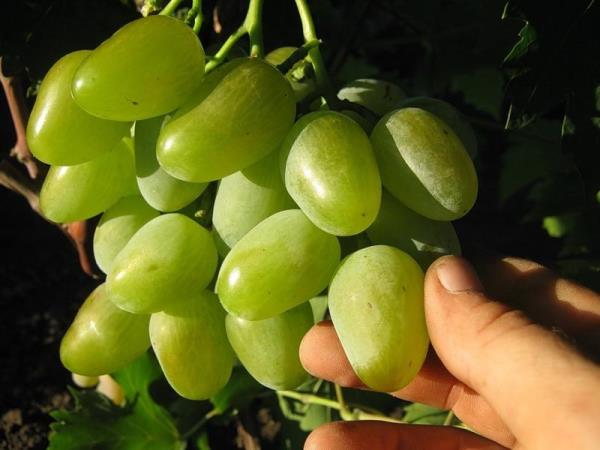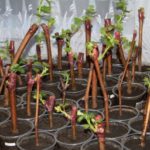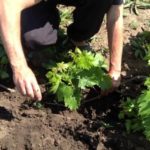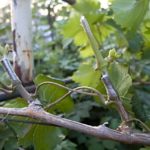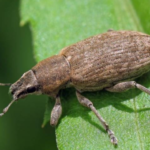Monarch grape is a unique variety that will always delight with its pleasant sweet taste. This grape variety has been successfully used in winemaking, thanks to its sophisticated flavor. Description and characteristics of the vine and berries are presented below.
Table of contents
Description of the grape variety Monarch
Monarch obtained by crossing grapes Cardinal and Talisman famous modern breeder E.G. Pavlovsky living in the Krasnodar Territory.In breeding varieties, genetic material of various varieties in the form of mixed pollen was used. Pollen processed the stigmas of the parent forms.
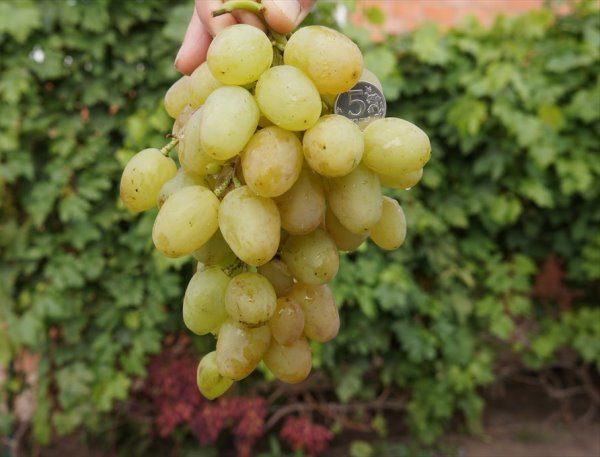
The main criteria for fruit crops:
- Yield very high. From one bush a maximum of 8 kg was received.
- Refers to medium early varieties, aging period 124 – 136 days. The month depends on the region, mainly it is the end of August and to September.
- Monarch variety not included in the State Register selection achievements. There is no official information about cultivation in a particular region. There are notes that the grapes grow in the cold and warm climate of Russia.
- Bears about a month, in one place grows about 9 to 24 years.
- Sugariness of fruits - 15 - 18 g / 100 ml; acidity - 4 - 5 g / l.
Characteristic berries
- Oval the formovoid
- Size of berries large, an average of 35 to 28 mm
- Weight berries average 22g, reaches 35g
- Coloring light green, rich. Ripened fruits change color to light yellow with small red spots on the sides.
- Seed in the berry 1 - 3 pieces
- Fruits not amenable temperature changesdo not rot
- Taste juicy sweet
- Medium density skin, nice crunches
- Aesthetic appearance
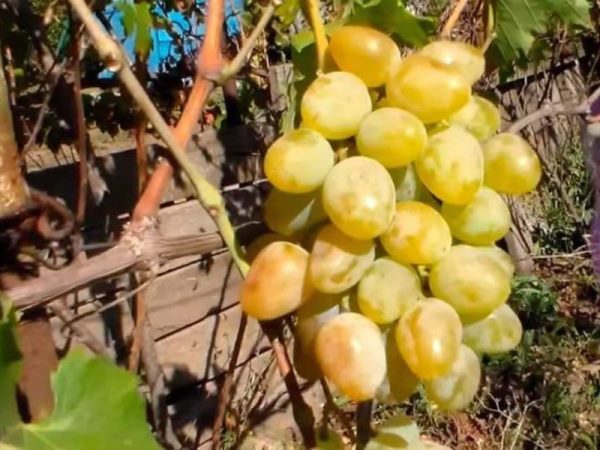
Advantages and disadvantages
The positive qualities of Monarch grapes include:
- Good frost resistance, maintains temperature to - 23 ° C
- Great survival rate of seedlings and cuttings in breeding varieties
- Possesses exquisite aroma and taste
- Skoroplodny
- Little damaged during transportation
- High yield
- High resistance to mildew and gray rot
- Relatively large shelf life
- Taste qualities do not depend on moisture, temperature
- Self-pollinated varietythat allows him to successfully bear fruit in greenhouses
- Rapid rise vegetative mass
- Not formed peas
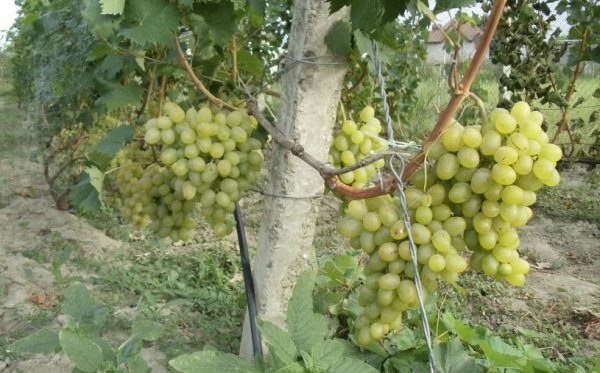
Negative characteristics of the variety:
- Not immune to phytopathological diseases - powdery mildew, oidium
- If you prune during flowering the ovaries are strongly showered it is also worth not to plant a plant in a windy area
- Shelter for the winter in regions where the temperature drops below minus 20 ° С
Planting a plant
Plant grapes should be annual seedlings, as well as can be grown from seed. But this is a long process and not always successful.
Location selection
If the site already grows solanaceous, horseradish, corn, sorrel, parsley, clematis, calendula, etc. (crop compatibility with each other), then you should not plant grapes near.
This culture loves the sun and does not tolerate shading. Therefore, the south or west side of the plot is suitable. The place you need to choose protected from the wind.
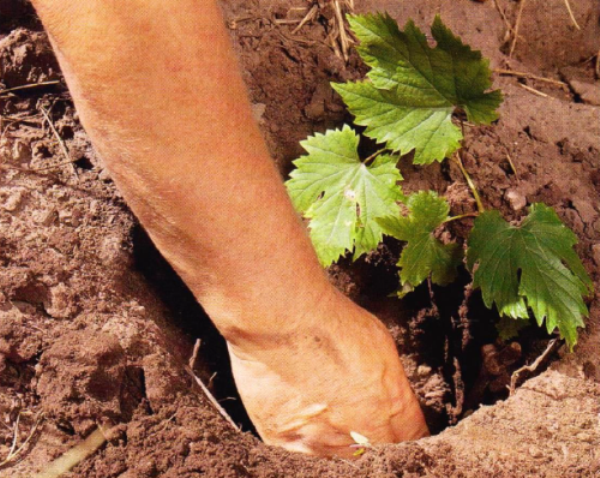
Planting time is suitable for both autumn (October) and spring (April, May).
Recommended soil and landing
The soil for the crop should be fertile, black soil is perfect. The grape root system develops up to one and a half meters, This means that the groundwater should lie below this horizon. Soil with poor air permeability is not suitable for growing grapes, for example, clay or marshy.
Planting:
- Landing pit should be for an annual sapling 70 to 70 cm, depth equal to two heights of the root system.
- Pre can spend watering holes, so that the soil has settled, then leave it for 2 - 3 hours
- The drainage layer is poured into the pit., grapes love stony soils where moisture and air passes well
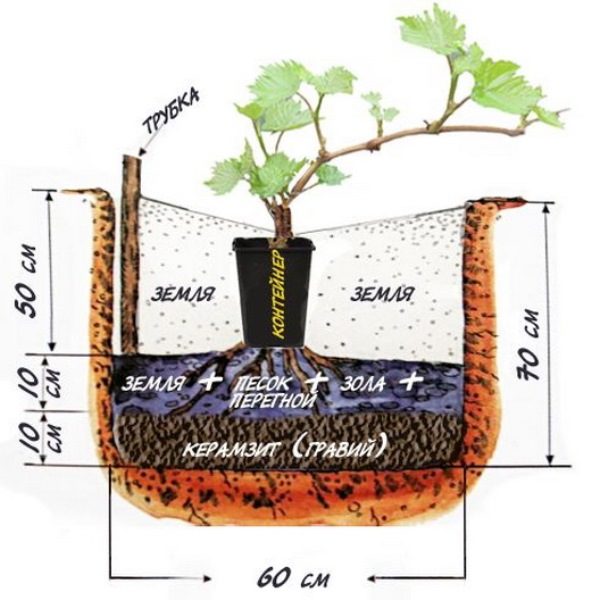
- Then drainage sprinkled with soil (with fertilizer applied) and plant a plant on top, spreading the roots along the hill formed
- Bury a hole ramming the soil and making a moat to accumulate moisture.
- Mulchrecommended by residues of weeds
- Watering
Landing patterns
There are several ways to arrange grapes. On home plots, grapes are most often allowed to hover over the gazebo wall, or they create a shady space with it, setting horizontal trellis.
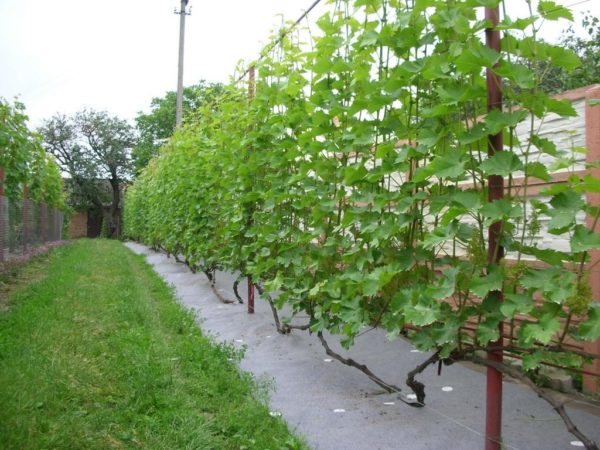
Two ways of placing culture are popular:
- Tapestry the way
- Field the way
With the help of trellis, you can adjust the height and width of the vineyard is suitable for home gardens.
The field method speaks for itself, there are also trellis present. But vineyards are located in a long row, occupying huge plantations. The height does not exceed 1.5 meters.
Plants when planting should be located more than 1 m apart.
Care
Plant care:
- Watering is carried out depending on climatic conditions. It is necessary to monitor the condition of the soil and the plant, as well as to draw up a watering schedule, which will also take into account rainfall.
- Mineral fertilizers 4 times per season. Nitrogen, phosphorus, potassium in the spring; then repeat at the beginning of the years; potassium, phosphorus at the end of summer; repeat in late autumn.
- Organic fertilizer under the mulch layer, twice in the spring, 2 times in the summer.
- Trimming three types: sanitary, at the beginning of development - forming and rejuvenating in the old vineyard.
Breeding methods
Reproduction occurs vegetatively and generatively. Generative reproduction is the formation of seeds. Vegetative reproduction with cuttings and layering.
- Reproduction by cuttings
- Laying grape slips
- Graft cutting
Also, to create a more durable and strong plant, use a single variety graft.another. Thus, for example, grapes of the best in taste cannot fully develop in arid zones. In order for it to bear fruit well, it should be grafted onto wild grapes with a more powerful horse system.
Diseases and pests
The most dangerous disease for grapes is powdery mildew. To combat it, there are chemical, biological and folk methods that can be used in small quantities.
Vineyard pests: Turkish skosar, biennial grape moth, grape varieties, grape mealy worm, garden spider mite. Pest control is to comply with agrotechnical standards, if necessary, the use of biological and chemical preparations.
- Turkish skosar
- Garden spider mite
- Grape mealybug
- Grape spotting
- Biennial grape leafworm
It should be concluded that Monarch grapes are easy to grow and have a lot of positive qualities.. It is significantly difficult to work with this variety because it is not regionalized, hence the difficulty in choosing a suitable region.
